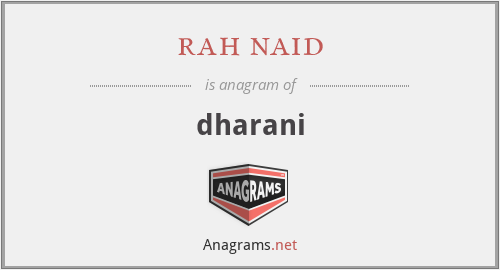What anagrams are available for dharani?
This page is about an anagram for the word rah naid that can be used in word games, puzzles, trivia and other crossword based board games.
rah naid
Translation
Find a translation for rah naid in other languages:
Select another language:
- - Select -
- 简体中文 (Chinese - Simplified)
- 繁體中文 (Chinese - Traditional)
- Español (Spanish)
- Esperanto (Esperanto)
- 日本語 (Japanese)
- Português (Portuguese)
- Deutsch (German)
- العربية (Arabic)
- Français (French)
- Русский (Russian)
- ಕನ್ನಡ (Kannada)
- 한국어 (Korean)
- עברית (Hebrew)
- Gaeilge (Irish)
- Українська (Ukrainian)
- اردو (Urdu)
- Magyar (Hungarian)
- मानक हिन्दी (Hindi)
- Indonesia (Indonesian)
- Italiano (Italian)
- தமிழ் (Tamil)
- Türkçe (Turkish)
- తెలుగు (Telugu)
- ภาษาไทย (Thai)
- Tiếng Việt (Vietnamese)
- Čeština (Czech)
- Polski (Polish)
- Bahasa Indonesia (Indonesian)
- Românește (Romanian)
- Nederlands (Dutch)
- Ελληνικά (Greek)
- Latinum (Latin)
- Svenska (Swedish)
- Dansk (Danish)
- Suomi (Finnish)
- فارسی (Persian)
- ייִדיש (Yiddish)
- հայերեն (Armenian)
- Norsk (Norwegian)
- English (English)
Definition
What does dharani mean?
- Dharani
- Dharanis (IAST: dhāraṇī), also known as Parittas, are Buddhist chants, mnemonic codes, incantations, or recitations, usually the mantras consisting of Sanskrit or Pali phrases. Believed to be protective and with powers to generate merit for the Buddhist devotee, they constitute a major part of historic Buddhist literature. Many of these chants are in Sanskrit and Pali, written in scripts such as Siddhaṃ as well as transliterated into Chinese, Korean, Japanese, Sinhala, Thai and other regional scripts. They are similar to and reflect a continuity of the Vedic chants and mantras.Dharanis are found in the ancient texts of all major traditions of Buddhism. They are a major part of the Pali canon preserved by the Theravada tradition. Mahayana sutras such as the Lotus Sutra and the Heart Sutra include or conclude with dharani. Some Buddhist texts, such as Pancarakṣa found in the homes of many Buddhist tantra tradition followers, are entirely dedicated to dharani. They are a part of the regular ritual prayers as well as considered to be an amulet and charm in themselves, whose recitation believed to allay bad luck, diseases or other calamity. They were an essential part of the monastic training in Buddhism's history in East Asia. In some Buddhist regions, they served as texts upon which the Buddhist witness would swear to tell the truth.The dharani-genre of literature became popular in East Asia in the first millennium CE, with Chinese records suggesting their profusion by the early centuries of the common era. These migrated from China to Korea and Japan. The demand for printed dharani among the Buddhist lay devotees may have led to the development of textual printing innovations. The dharani records of East Asia are the oldest known "authenticated printed texts in the world", state Robert Sewell and other scholars. The early-eighth-century dharani texts discovered in the Bulguksa of Gyeongju, Korea are considered as the oldest known printed texts in the world.Dharani recitation for the purposes of healing and protection is referred to as Paritta in some Buddhist regions, particularly in Theravada communities. The dharani-genre ideas also inspired Buddhist chanting practices such as the Nianfo (Chinese: 念佛; Pinyin: niànfó; Romanji: nenbutsu; RR: yeombul; Vietnamese: niệm Phật), the Daimoku, as well as the Koshiki texts in Japan. They are a significant part of the historic Chinese dazangjing (scriptures of the great repository) and the Korean daejanggyeong – the East Asian compilations of the Buddhist canon between the 5th and 10th centuries.
Embed
Citation
Use the citation below to add this anagram to your bibliography:
Style:MLAChicagoAPA
"rah naid." Anagrams.net. STANDS4 LLC, 2025. Web. 22 Jan. 2025. <https://www.anagrams.net/term/20364003>.




Discuss this dharani anagram with the community:
Report Comment
We're doing our best to make sure our content is useful, accurate and safe.
If by any chance you spot an inappropriate comment while navigating through our website please use this form to let us know, and we'll take care of it shortly.
Attachment
You need to be logged in to favorite.
Log In